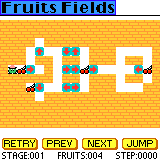People interested in retrogaming and retro-remakes may know Ignacio Pérez Gil, who remade a number of classic Spanish and ZX games. Apart from that, he created a few Visual Basic 3.0 games, which I recently uploaded. Since he started programming in 1997, these are some of the latest games for 16-bit Windows.

90% of the people who start programming games,
he writes, make a Master Mind. And I’m not the exception…

Qúbix is a 3D Tic-Tac-Toe, developed up to version 3 in 2000. Though the author says that it has three difficulty levels: easy, very easy and ridiculously easy,
I found it quite tough to beat. Maybe I just don’t play very well. I liked the way it occasionally comments in the title bar.

Parchís is the Spanish variant of the cross and circle game family. This is possibly the only implementation for 16-bit Windows, developed up to version 2.1, 2001.

Deflektor PC was his last Visual Basic game, the only one that runs in 256 colors, and the only one with an optional English interface. He started to work on it in 1998, originally just as a practice, like the other games. In 2004 he abandoned it and started from scratch in C/Allegro, with completely new graphics. The graphics of the VB version are actually very good, since they retain the look and feel of the Sinclair ZX Spectrum, yet improve it in subtle ways, which is exactly what remakes should be about.





